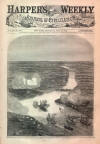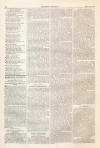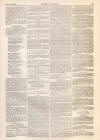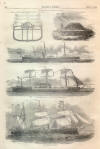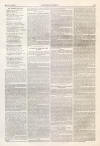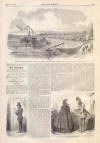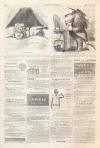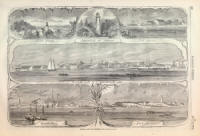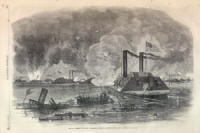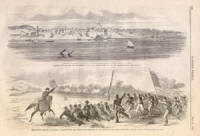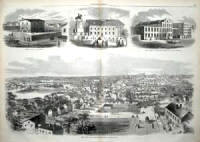|
This Site:
Civil War
Civil War Overview
Civil War 1861
Civil War 1862
Civil War 1863
Civil War 1864
Civil War 1865
Civil War Battles
Confederate Generals
Union Generals
Confederate History
Robert E. Lee
Civil War Medicine
Lincoln Assassination
Slavery
Site Search
Civil War Links
Civil War Art
Mexican War
Republic of Texas
Indians
Winslow Homer
Thomas Nast
Mathew Brady
Western Art
Civil War Gifts
Robert E. Lee Portrait
|
MY ABSENT SOLDIER.
EVENING shades are falling,
dearest! Night is coming on;
And the sweet stars look out
shyly, Slowly, one by one;
And I count them with my forehead
Pressed against the pane,
And thinking of the time,
dearest,
When we shall meet again!
When I fold my hands, dearest,
To breathe a good-night prayer,
Whose name is it that lingers
longest
Upon the evening air?
Yours! And then I slumber
sweetly,
For I know our Lord
Through the night's long hours of
darkness Hath you in his ward.
How much I think of you, dearest!
I know that very oft
My features rise before you,
And then your voice grows soft:
They do not know the reason
It thrills and trembles so;
'Tis the beautiful heart music
That makes it sweet and low.
God bless you, my own darling!
And keep you pure and fair;
May the calm glory of your eyes
Be darkened by no care.
Your love—the dearest, next to
God's!
Your worth—my highest pride!
Good angels guard your homeward
steps,
And haste you to my side!
But if—Ah, God! the bitter
thought—
You should not come again;
If you should lie out in the
night Among the battle's slain!
I could not bear such anguish,
love,
For all that I could do;
I know my widowed heart would
break,
And I should perish too!
BRITISH IRON-CLAD VESSELS.
THE exploits of the
Monitor and
the Merrimac have roused the British to the necessity of bringing up their navy
to the modern standard, and accordingly we find that iron-clad vessels are being
rapidly constructed at all the British dock-yards. We give, on
page 342, several
illustrations of the new iron-clad ships which are being constructed. The ship
which the English seem to consider the most formidable of their new fleet is the Defence—an iron-clad steam ram, carrying guns. We condense the following account
of the Defence from the British papers:
She was built for the Government
by Messrs. Palmer, of Jarrow, on the Tyne, and is of the following dimensions:
Length between perpendiculars, 280 feet; breadth, 54 feet; depth of hold, 18
feet 3 inches; burden in tons, 3668; with engines of 600-horse power.
The Defence recently returned to
Spithead after a trial-trip of nineteen days; a week of that time she lay in
Plymouth Sound, so that but twelve days were spent in ascertaining her qualities
at sea. Thanks to the proverbially changeable nature of the weather at this
season of the year, the time, brief as it was, afforded many good opportunities
of testing her. The wind, though never violent, was at times sufficiently strong
to designate it a gale, and to cause a rather heavy sea. Her conduct under these
circumstances was excellent evidence as to her capability to encounter worse or
even the worst of weather. It is stated that her good qualities as a ship of war
exceeded the expectations of all who had to do with her.
Her steering qualities, without
being so bad as has been represented, are doubtless inferior; her symptoms are
precisely those of a ship too much immersed, being sluggish in answering her
helm, and apt to take broad shears when her head once makes a start.
The quantity of canvas she
spreads is very small in proportion to her tonnage; nevertheless she is
perfectly manageable under sail, and attains a speed of about two-thirds the
usual rate of sailing of an ordinary frigate. Under steam her greatest speed is
about eleven knots.
She is described as being
remarkably easy in a seaway. No wooden ship would have the smallest chance
against the Defence if the latter could use her guns or her prow. The
projectiles thrown by the Defence would speedily fire a timber-built ship, and
her formidable stem would certainly crush in the side of any such vessel.
The most popular class of vessels
in England at present, however, are imitations of
Captain Ericsson's
Monitor,
adapted by a Captain Coles, who modestly claims the invention as his own. We
give a picture of a "CUPOLA SHIELD FRIGATE FOR FOREIGN SERVICE," from Captain Coles's models. This vessel is to be 260 feet long, 45 feet beam, 21 feet
draught, and 1000-horse power. She is to carry four 150-pounder Armstrongs, or
eight 110-pounders, and her bow is to be heavily armed with iron, so as to
enable her to be used as a ram at close quarters. The first of these
cupola-shield frigates is to be launched in February, 1863.
Captain Coles not only proposes
to build new cupola-shield frigates, but professes his capacity to cut down
line-of-battle ships into Monitors. We publish an illustration of one of the
great BRITISH LINE-OF-BATTLE SHIPS CUT DOWN according to his plans, and likewise
a sectional view of the same. The vessel, as razeed, will be 250 feet long, 58
feet beam, 23 feet draught, and 1000-horse power. She will carry five
150-pounders, or ten 110-pounders, Armstrongs.
A small diagram, on the same
page, shows the effects of gun-practice against one of Captain Cowper Coles's
cupolas. It does not seem to have been much injured; but perhaps the guns were
small of their kind.
The first of Captain Coles's
ships will be launched
in February, 1863. By that time
the United States will have 35 iron-clads afloat, including at least twelve
Monitors.
THE BATTLE AT FORT DARLING.
WE illustrate on
page 337 the
unequal conflict between our gun-boats Galena and Monitor and a powerful rebel
fort called Fort Darling, on the banks of the James River, some seven miles from
Richmond. It seems that our gun-boats Galena, Monitor, Aroostook, Port Royal,
and Naugatuck advanced up the James River to within seven miles of Richmond,
passing or silencing the batteries as they advanced. At Fort Darling they found
the river obstructed with sunken vessels and stones, and were exposed to a heavy
plunging fire from a fort situate on a bluff 200 feet high. The Naugatuck burst
her gun—a 100-pounder Parrott—at the 7th fire. The wooden vessels sheered off,
being incapable of standing the fire from the fort and the rifle-pits with which
the river shores were lined. For four hours the Galena and Monitor fought the
forts at great disadvantage. They were exposed to a plunging fire which they
were not built to withstand; the deck of the Galena was perforated by almost
every shot, and her loss in killed and wounded was heavy. Neither vessel could
elevate her guns sufficiently to silence the batteries of Fort Darling. After
four hours' fighting the squadron therefore withdrew.
Commodore Goldsborough has since
gone up the the river with his squadron and some mortar-boats, with which it is
believed he will soon be able to take Fort Darling and clear the way to
Richmond.
RICHMOND, MEMPHIS, AND
MOBILE.
WE publish in this week's paper
views of three rebel cities, all of which we hope to be able to report have
fallen into the hands of our brave troops by the time our next paper is
published.
RICHMOND.
On pages 344 and 345 we give
RICHMOND, VIRGINIA, THE REBEL CAPITAL, together with Vignettes of the various
PRISONS in which so many of our poor brothers have languished during the past
year. The following account will be read with interest:
Richmond is situated on the James
River, 23 miles north of Petersburg, 113 south by west of Washington, and about
150 miles from the mouth of the river. Its population in 1854 was 30,000; its
exports about $3,000,000, chiefly wheat and tobacco.
The principal feature that
strikes every one who sees Richmond for the first time is its curious
topography. From the James River, which, tumbling over its rocky bed, makes a
wide bend here, with its convex face to the city, rise, without any regard to
uniformity of direction, some half dozen hills of gravel formation and of pretty
considerable elevation. There has never been any attempt to grade them into
level streets, but the city is scattered promiscuously up and on and over them,
just as fashion, taste, or business may have happened to dictate. The principal
part of the city, however, occupies actually only one of those elevations, and
the garden spot of that one is the Capitol Square, where stands the building of
which Jefferson procured the design in France, but which, however magnificent it
may have been deemed in the simple, unostentatious days in which it was built,
is certainly not to be lauded now either for its beauty or for its adaptation to
the wants of a State Legislature, much less to those of a Congress of
Confederate States. In the centre of the Square is the beautiful equestrian
statue of Washington, looking as calm and serene and commanding as if the city
which he overlooks was not the centre and hot-bed of the foulest treason that
ever showed itself in the light of day. The pedestal is designed for eight other
statues of distinguished Virginians, but three of which have yet been put in
their places. These are Jefferson, Henry, and Mason—not the arrogant,
self-conceited blockhead who recently represented the State in the Senate at
Washington, and has now gone seeking recognition at London as the diplomatic
representative of secessiondom, but a far purer, wiser, and more patriotic
namesake of his. Here also is a small statue of Henry Clay.
Richmond has really but one
business thoroughfare. That is Main Street. Most of the hotels, banks, newspaper
offices, and stores are located on it. It extends northward into the open
country, and southeastward to a suburb called Rocketts. In this latter section
of it are situated some of the tobacco warehouses where our Union prisoners are
now confined. These are large old brick edifices, of mouldy, dilapidated
appearance. They stand three together on one side of the street—which here is of
a most dingy character—and two nearly opposite. Those on the north side are
overlooked by the bluffs in which Church Hill here terminates, and which supply
gravel for the city, while those on the south side of the street have the James
River and Kanawha Canal, and the river itself immediately in their rear.
Near the summit of the elevation
known as Church Hill is a large, old-fashioned brick building known as the
alms-house. It has been converted from its original purpose, and now serves as a
hospital for our sick and wounded. Sisters of Charity come and go, untiring
angels of consolation, and the hearse is kept in constant requisition, so great
is the mortality that prevails here. Many of the private houses in the vicinity
are also converted into temporary hospitals. As a general thing, the former
residents of this part of the city have gone elsewhere since the location of the
hospitals here; and now on every tenth house or more you see waving a little
dirty, whitish-yellow flag, denoting a lazaretto. The Odd Fellows' Hall, on
Broad Street, is also used as a general hospital. On the most commanding part of
Church Hill still stands, in good preservation too, the church in which Patrick
Henry made the famous speech at the commencement of the Revolutionary struggle,
where he used that memorable and oft-quoted phrase, "Give me liberty, or give me
death:" Around the church are the graves of the last generation of the people of
Richmond, and I was no little disgusted to observe that few of the head-stones
had escaped the profane Vandalism of some scoundrels, who, as a proof of their
wit, cut the figure "1" before the figures recording the ages of the deceased,
making it appear that those who rested here from their labors had enjoyed
incredibly patriarchal length of years.
Between this hill and the rickety
suburb known as Rocketts there is a large encampment, and I believe there are
also batteries here, for the defense of the river. I know that there certainly
are batteries on the bluffs, above and beyond Rocketts. Near here the few
steamers and sailing craft that used to trade to Richmond had their
mooring-places, and here also the James River and Kanawha Canal has its southern
outlet into the river. This is a great work of internal improvement, so far as
the design is concerned; but, unfortunately for Virginia, her execution does not
keep pace with her plans, and the canal, though open for many years, does not
come within a long distance of the Kanawha River, which it was intended to tap.
If it ever will do so, it must be after secession is crushed and the Union
restored.
MOBILE.
Mobile, Alabama, of which we give
several views on page 340, is one of the largest cities on the Gulf.
It is on the junction of the
Alabama and Tombigbee rivers, at the head of Mobile Bay.
The city is an old one, having
been held successively by the British and Spaniards before it came into our
possession.
The city is built upon a plateau
elevated some fifteen feet above high-water-mark, thirty miles from the mouth of
Mobile. Bay, the entrance to this bay being protected by Forts Morgan and
Gaines.
Fort Morgan was known as Fort
Boyer during the war of 1812, when the gallant Major Lawrence defended it
successfully against repeated attacks both by land and sea. The fort since then
has been rebuilt and strengthened, and was but a short time since one of the
most picturesque and interesting of our sea-coast defenses. In shape it is a
pentagon trace, built upon regular angles, protected on the sea front by a
strong water-battery of masonry and turf. The greater number of the guns of the
fort are Columbiads of heavy calibre, with an occasional rifle upon a salient. A
bomb-proof citadel in the centre of the fort, pierced for musketry, affords a
secure retreat during a bombardment, as well as a dernier resort from a
successful storming party. The fort and water-battery, with their full armament,
mount forty-five guns.
Fort Gaines, the other fort which
protects Mobile, is situated on Dauphin's Island Point, three miles and
one-fourth from and nearly opposite Fort Morgan. This fort was under
construction at the outbreak of the rebellion, and, if finished, would have
mounted eighty-nine guns.
The rebels, making a virtue of
necessity, have now deferred its completion, and are making use of those
portions nearly finished, which, with the sand-batteries that have been erected,
make them exceedingly confident of their ability to sustain and withstand any
attack that may be made upon them.
Grant's Pass is the one through
which the New Orleans steamers used to puff their way before the regularity of
their trips were interfered with by a healthy fear for their safety; for truth
to say, the probability is that a steamer would make but a small portion of her
journey now ere she fell into the safe keeping of one of the many gun-boats that
compose our Gulf squadron. This pass has been fortified and protected in the
best manner possible under the circumstances, sand-batteries having been erected
upon either side of the little island upon which the keeper of the pass and
light used to live.
MEMPHIS.
Memphis, Tennessee, of which we
give a view on page 348, is probably by this time in possession of our forces.
The following description of the place is accurate:
Memphis, previous to the
rebellion, was a flourishing city and port of entry of Shelby County, Tennessee,
and is beautifully situated on the Mississippi River, just below the mouth of
the Wolf River. It is located on what is known as the fourth Chickasaw Bluff,
which is about forty feet high nearest the shore. It is distant from St. Louis
about four hundred and twenty miles by water, and from Nashville about two
hundred and nine miles, in a west-southwesterly direction. It was at one time
considered the most populous and important town on the river between St. Louis
and New Orleans, and occupies the only eligible site for a commercial depot from
the mouth of the Ohio to Vicksburg—a distance of at least six hundred and fifty
miles. The bluff on which the city stands, and before alluded to, is elevated
about thirty feet above the highest floods, and its base is washed by the river
for a distance of three miles; a bed of sandstone projects into the stream and
forms a complete, convenient, and natural steamboat landing. The appearance of
Memphis from the river is exceedingly fine. An esplanade, several hundred feet
wide, extends along the bluff in front of the town, and is bordered with blocks
of large warehouses. The population, since 1854, has doubled itself, and was
still rapidly increasing when the troubles commenced. It contains several
churches, an academy, a medical college, two banks, and a telegraph office. A
naval depot was established there by the United States Government, but proved a
failure. The river is, however, deep enough to float a very large ship-of-war,
and the rebels have taken advantage of the money expended by the United States
Government to use the Navy-yard for the purpose of building vessels to oppose
their navy. The means of communication to and from the city are good, and the
trade of the place has been excellent. In 1840, the population was 3300: in 1850
it had increased to 8841, and in 1853 it was estimated at 12,000. What it now is
can not be definitely stated.
THE SKIRMISH AT PEA RIDGE,
TENNESSEE.
Wit illustrate on
page 348 a
remarkable incident of the Battle of Pea Ridge, Tennessee, when the Eighth
Missouri Regiment charged over the Eighteenth Regulars—the latter being composed
of raw recruits, and showing an unwillingness to charge. The artist thus
describes his picture:
PITTSBURG LANDING, TENNESSEE,
April 25, 1862.
To the Editor of Harper's Weekly:
Inclosed herewith please find
sketches of a sharp little action which took place yesterday, some seven miles
from here. A reconnoitring force, consisting of two regiments from each
division, was sent out early yesterday morning to ascertain where the main body
of the enemy lay. Some seven miles from camp the advance-guard of the Eighth
Missouri Volunteers discovered the videttes and pickets of the enemy directly in
front and posted in the edge of the woods, and advancing drove them in. Our
forces coming up discovered three regiments of rebels drawn up in line of battle
in the edge of the woods on the other side of a large open field, and protected
by a strong fence. At this juncture the Eighteenth United States Regulars,
having the advance, refused to go forward (this is a new regiment), the enemy
having opened a heavy fire upon them. Colonel Morgan L. Smith, commanding the
Eighth Missouri, seeing this, gave his famous regiment the word, and off they
went, double-quick time, over the regulars and after the rebels, firing as they
ran. In the mean time, however, one of our batteries had been pouring shot and
shell into the enemy's ranks and had broken them. The Seventy-sixth Ohio and
Captain Powell's cavalry made their appearance, coining up from woods in the
rear. This was the signal for flight upon the part of the enemy, and they obeyed
it. Our forces then burned their camp—large amounts of clothing, stores,
officers' trunks, etc.—besides capturing quantities of ammunition and arms. Nine
prisoners were taken, and the estimate of the rebels killed, made by one of the
artillery officers, is thirty. Not a man was lost by our forces.—In haste,
yours,
J. F. GOOKINS
P.S.—I find I have made one
mistake. The Eighth Missouri was commanded by Lieutenant-Colonel James Peckham;
Colonel M. L. Smith, of the Eighth, leading the brigade.
GUN-BOAT FIGHT ON THE
MISSISSIPPI.
ON
page 341 we illustrate the
combat which took place on the Mississippi River, off Fort Wright, on 8th May.
The correspondent of the Herald thus describes the scene:
The morning was one of the finest
of the season, though, as is very common in this region, before sunrise a dull
haze spread over the water, making it difficult to see at any great distance
away. Just at daylight the mortar-boats were towed down to their positions,
ready for their day's work. This morning the gun-boat Cincinnati was sent down
with them as a precautionary measure. The latter dropped anchor just abreast of
the mortars, and but a short distance out in the stream. Scarcely had she
swung around and become settled
in her position when the look-out gave the signal, "Steamer astern!" Sure
enough, by peering through the masts, a low, dark object was discovered, bearing
a strong resemblance to a steam craft of some kind. It was subsequently
ascertained to be the rebel ram Louisiana. All hands were beat to quarters, and
the gun-boat was cleared for action immediately. The promptness of the response
of the men in putting the boat in fighting shape was most remarkable. The anchor
was up almost simultaneously with the issue of the order, the decks were cleared
of all rubbish and every thing in the shape of obstruction, and every man was
standing at his gun. By this time the rebel craft had approached near enough to
be readily recognized, and just as the early sun was dispelling the haze the
Cincinnati swung around and welcomed the visitor with a full broadside. As the
sound of the report and its tremendous reverberations ran along the shore and
reached the ears of those manning the other boats of our fleet, there was one
general shout of gladness as every officer and man sprang to his feet and
prepared for duty. With the report came also reinforcements to the rebel boat.
Three in number, they came quickly around the point, and prepared to grapple
with the spunky Yankee. The Louisiana ram carried two heavy rifled pieces, both
of which, together with the guns of her consorts, were soon bearing upon the
Cincinnati, and throwing in shot after shot in rapid succession. But against
them all the Cincinnati boldly held her position, her sloping iron sides
repelling their heaviest missiles as though they were but paper balls. This
unequal contest lasted for full twenty minutes, during all of which time the
rebel gun-boats were kept in check by the Cincinnati alone. The ram, however,
ran up close to the Union boat, and manifested a disposition to run her down.
Just at this juncture the other
iron-clad boats of our fleet came to the rescue—the Benton (flag-ship),
Carondolet, Pittsburg, Cairo, and St. Louis—and relieved the Cincinnati of the
necessity of giving any further immediate attention to the rebel gun-boats, thus
enabling her to close in with the ram alone.
The Louisiana came along up,
under full steam, until nearly upon the Cincinnati, when the latter put her head
about and avoided the well-intended blow. Her crew were on deck, armed with
cutlasses, boarding pikes, and carbines, fully prepared for a close hand to hand
encounter. The ram, foiled in her first attempt, withdrew a short distance, and
again turned upon the Union boat. This time she got her sharp bow full in upon
the heavy iron sides of the Cincinnati; but her headway was not sufficient to
cause any very serious damage. Before she could get away, however, Captain
Stembel, commanding the Cincinnati, rushed upon the hurricane deck, and, seizing
a pistol, shot the rebel pilot, killing him instantly. 'rhe rebel crew
retaliated, when a musket-ball entered the gallant Captain's right shoulder,
high up, nearly to the neck, and passed quite through. The wound was a
troublesome and painful one, but not sufficiently serious to detain the Captain
from his post longer than to have it dressed. In the mean time the ram had
prepared for another assault, and this time evidently with the intention of
boarding her antagonist. She came up under full headway, and with her steam
batteries ready for immediate us. Just as she struck the Cincinnati, however,
her steam apparatus collapsed, scalding a large number of her crew. Captain
Stembel was also prepared with his steam battery to add to their discomfiture,
and almost simultaneously with the explosion a dense volume of scalding water
and steam came pouring upon the rebel crew front the deck of the gun-boat. This
was too much for them to withstand, and those who were left uninjured and alive
managed to get their craft away beyond the reach of further injury.
The casualties on the Cincinnati
were very slight. Her gallant commander was wounded, as mentioned above. Her
first master received a flesh wound in his thigh, and two seamen were slightly
wounded.
As the ram drew away the
iron-clad gun-boat Mallory appeared as a new antagonist. This is one of the new
boats of which so much boast has been made by the rebels. She had just been
completed at Memphis, and on this occasion made her first public appearance. She
was a powerful craft carrying ten or twelve guns, and sheathed with heavy boiler
iron over heavy timber bulkheads stuffed with cotton.
Her first manoeuvre was an
attempt to run the Cincinnati down by butting against her. This was baffled by
the dextrous handling of the latter boat, though several times attempted. Then
she hauled alongside and opened a close fire, but received rather more than she
gave. The heavy
Dahlgrens of the Union craft were too much for her, and again
she resorted to the battering process. Just as she was preparing to strike, with
all the power of momentum acquired by a quarter of a mile's running, the St.
Louis—Union iron-clad boat—bore down upon her, and, striking her fairly
amidships, nearly cut her in two. She sank almost immediately, and within two
hundred feet of the vessel she was attempting herself to run down. The most of
her crew must have perished, though a number were picked up by our boats. She is
a total loss, having sunk in deep water.
Comparatively few of our shots
were wasted. They were all admirably directed and did wonderful execution, as
the condition of the rebel boats fully shows. But their execution was better
apparent in the explosion and total destruction of two of the most powerful of
the rebel gun-boats. The names of these I have not yet been able to ascertain.
Their destruction occurred nearly
at the same time and when the engagement was at its height. Above the loud din
of the cannon could occasionally be heard the shouts and cheers of the loyal
crews as they discerned one and another evidence of their sure approaching final
triumph. The whole scene was shut out from view by the dense volumes of smoke
that settled over the fleet, the result of the heavy firing. There was something
grand and inspiring in all this, even to one outside, who could only hear the
din and see the smoke. But suddenly there came a report louder than, and
distinguishable above, all the others; and accompanying it could be seen a
volume of white smoke rolling and surging above the other smoke, and bearing on
its rolling waves black masses and fragments, which again quickly disappeared.
What was it? The smoke lifted and revealed the cause. A well-directed shell had
struck in the magazine of a rebel boat, causing an instantaneous explosion of
the shell, magazine, and boilers. The boat was blown to atoms, and her crew
perished with her. It was a fearful casualty, and one that is well calculated to
awaken the deepest sympathy and pity for the poor unfortunates thus suddenly
sent into eternity; but "it is the fortune of war," and the din goes on, and
more destruction is attempted.
During the heat of the engagement
one of the rebel rams—supposed to be the Manassas—singled out the Benton as its
prey. The latter at first scarcely deigned to notice so insignificant an
adversary, but continued to devote her time to the heavier gun-boats. Her
powerful guns were all at work. She was kept in constant motion, first
discharging her four bow guns, then hauling about and letting go her broadside
of five pieces, and again bringing her stern pieces in range, and so on until
the round was completed. All this time the ram danced about, endeavoring to get
a chance to give her is good butt. At last the opportunity arrived, and with a
powerful head of steam on the ram flew to her work. She struck the flag-ship
fairly, right amidships, but was doubtless much amazed, on withdrawing, to find
that she had suffered more damage herself than she had inflicted. Her nose was
badly jammed, while the solid iron sides of the Benton showed no signs whatever
of the assault. It was a signal discomfiture, rendered doubly annoying by the
reception of a round of grape-shot from her antagonist that compelled her to get
out of the way with the least possible delay.
By this time it was apparent that
the enemy must withdraw quickly or be wholly destroyed. They had entered the
contest with five gun-boats and three rams—eight in all. Three of their
gun-boats were totally destroyed. The remaining two, as also the rams, were
riddled through and through, and all appeared to be leaking badly. On the
contrary, our boats, excepting the Cincinnati, appeared wholly uninjured, and
were in condition to continue the action all day if necessary. Under these
circumstances the rebels had no alternative, and at twenty minutes past
seven—just one hour and twenty minutes after the commencement of the battle—the
last of them disappeared around Craighead Point, the heavy cannonading ceased,
the smoke cleared away, our boats returned to their moorings, and the battle was
ended.
|
